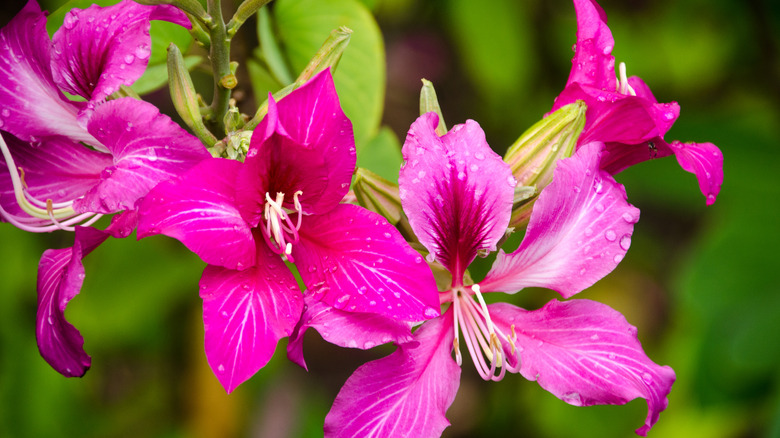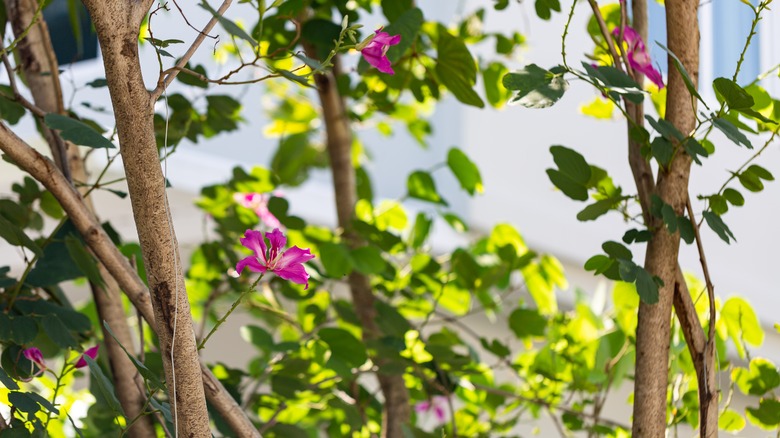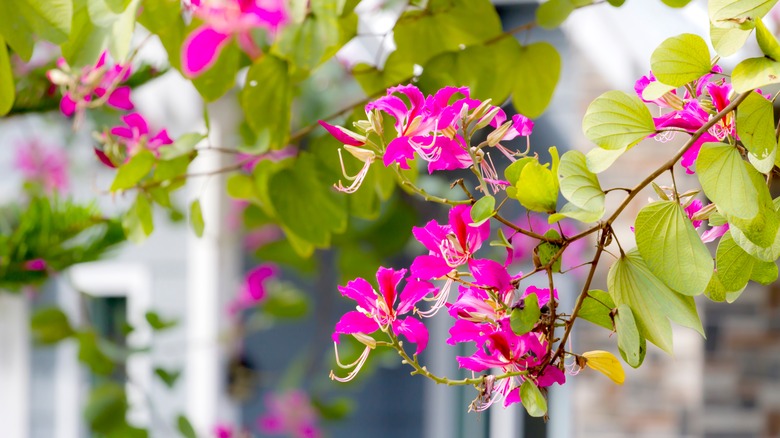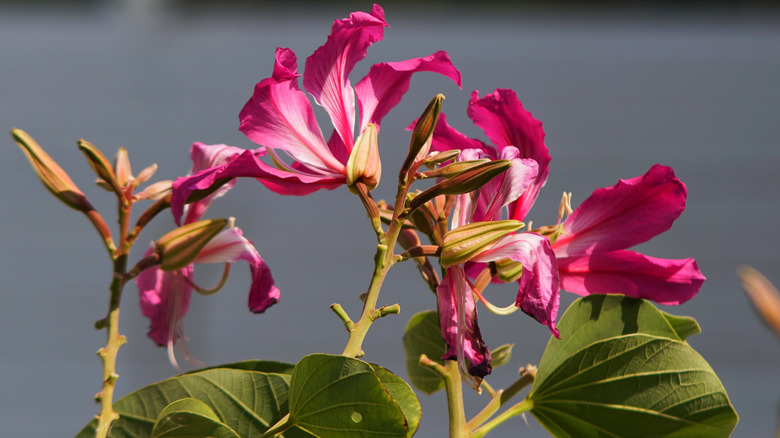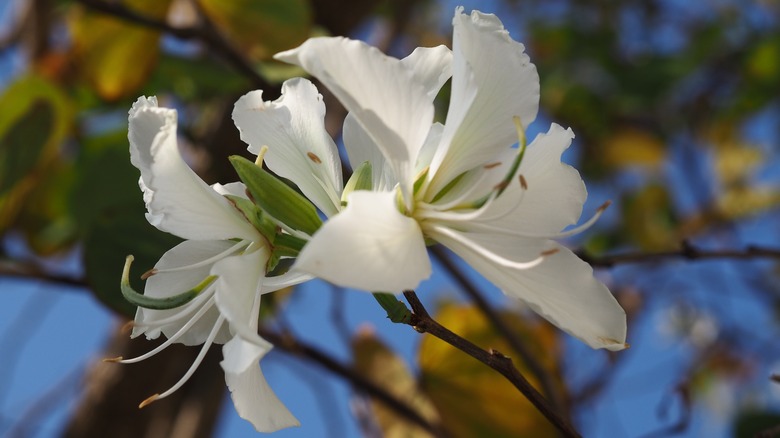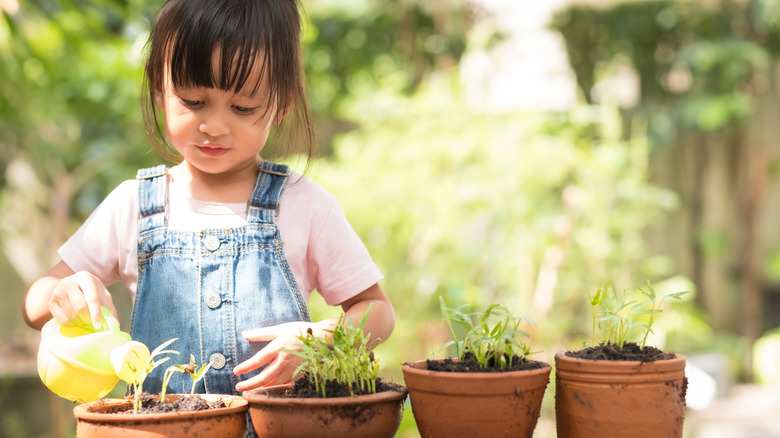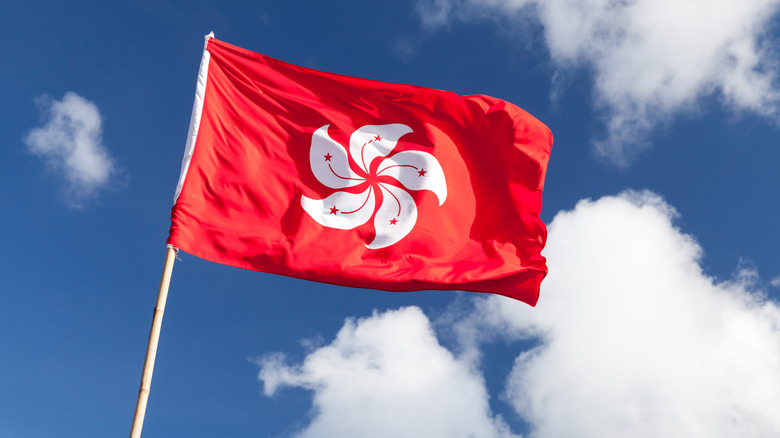How To Grow And Care For A Hong Kong Orchid Tree
Have you ever wondered which tree is deemed the most beautiful by plant care experts at a distinctly reputable nursery like Monrovia? Well, here you have it: Bauhinia x blakeana, the Hong Kong orchid tree. This tall semi-evergreen tropical beauty boasts gorgeous fuchsia flowers that look just like orchids and last equally as long. The blooms are large (up to 6 inches across) and emit a decadent scent that fills the air around you while delighting the senses of your neighbors strolling by. Each flower has five overlapping petals, five protruding stamens, and one pistil. Unlike other orchid trees, the Hong Kong variety does not produce seed pods and is, therefore, sterile.
These trees are only hardy to growth zones 9 through 11. It's possible to plant a young tree in a container, but it will inevitably outgrow its pot or simply be too heavy to move indoors in colder climates.
How to use Hong Kong orchid in the garden
Something unusual about this tree is that it's a winter bloomer: It offers a rich splash of color against the bleakness of deciduous trees that have shed their leaves from December through April. As such, South-Florida-Plant-Guide notes that the Hong Kong orchid tree is an excellent choice for those among us who get to spend their winters soaking up the Florida sun. Arrive just in time to see the first blooms burst forth and enjoy their sweet scent until it's time to head back north in the spring.
Hong Kong orchids are not the largest trees available, but they do shoot up to between 30 and 40 feet high with a crowned canopy spread of 25 feet. Due to their space needs and commanding presence, they should be planted in big yards where they will be the main point of attraction. Plant a minimum of 10 feet away from any walls or structures, preferably in an area where you intend to create shade. Wind protection is an important factor here as well. Due to their fast growth rate, the wood of Hong Kong orchid trees is not as dense as other sturdier trees, thus making them more likely to bend and possibly break in a high wind area. In suitable climates, civic landscapers often use them to line median strips along the highway and decorate parking lot islands.
How to grow a Hong Kong orchid tree
That X between the genus and species name (Bauhinia x blakeana) lets growers know that the Hong Kong orchid tree is a hybrid, meaning species were crossed to create it. Also, remember that it does not produce seed pods. This leaves you with two options for propagating new plants: stem cutting or air-layering. For stem cutting, follow the same simple steps you would with any other plant. Use sharp shears to make a clean cut on a thin branch just below a node, where a new smaller branch or leaf stem juts out and leave to root in a jar of water or plant it in soil.
Layering, as explained by the horticulturists at Oklahoma State University Extension, is also easy to do and can be accomplished by a novice gardener. To air-layer a Hong Kong orchid tree, locate a branch about 2 inches wide; it should be part way up the trunk and easy to reach. The gist of this process is to cut and peel off the bark of a section of the branch. Next, wrap the cut area first in pre-moistened peat moss, then in plastic wrap secured by ties or bands. Over time, new roots will grow into and through the peat moss. When these appear, the cutting can be removed and planted. If your first attempt fails, you may want to apply rooting hormone to the branch before wrapping it with peat moss.
How to care for a Hong Kong orchid tree
Orchid trees, in general, can make quite a mess of your yard as debris falls from the branches. The Hong Kong variety will not be dropping any seedpods, but the flowers and leaves will be plentiful. And they'll continue to fall throughout the tree's lengthy blooming period. Regular maintenance to keep your yard clear of too much decaying debris is important to avoid rotting organic matter that can damage grass or attract unwanted bugs.
Hong Kong orchid trees require watering, yet they are tolerant of drought and actually bloom in abundance when planted in sandy soil. Per Phoenix Tropicals, put them on the same watering schedule as your grass, and they'll even thrive in a hot desert environment. In most areas, this schedule will be every other day through the summer heat and less frequently during fall and winter. Although orchid trees are fast-growers, applying standard granular fertilizer won't hurt but may not be necessary. Left to grow on their own, these trees will become somewhat large. They can also be pruned back and maintained as shrubs or bushes.
Orchid tree varieties
All orchid trees produce gorgeous flowers that resemble but are not actually orchids. San Diego Zoo's Wildlife Alliance provides an excellent guide to the Bauhinia orchid tree genus and some of its most common species, which can bear blooms in shades of purplish pink, red, orange/yellow, or white.
- Bauhinia variegata and Bauhinia purpurea are both names for the common purple orchid tree. Unlike the Hong Kong hybrid, these trees produce and drop seedpods that can litter a yard and sprout spontaneously. They also have darker and rougher trunk bark.
- Bauhinia forficata (pictured above) is similar to the common purple orchid in all ways except that it produces white blooms.
- Bauhinia galpinii is a red flowering shrub variety that will top off between 10 and 15 feet tall.
- Bauhinia tomentosa is an even smaller shrub with a maximum height of 6 feet. This variety produces yellow flowers and lighter green leaves.
Is the Hong Kong orchid tree toxic?
It's true that orchid tree debris will make a bit of a mess in your yard, but it is unlikely to make a mess of your cats, dogs, or children. They are considered non-toxic and are, therefore, not included on the ASPCA's list of poisonous plants. The lack of seed pods may also make the Hong Kong variety a beneficial option for those with allergies. All this said, hungry or curious pets left in the yard are liable to munch on just about anything they find. Too much of even a good thing can cause mild stomach upset. So there's one more reason to rake up and discard debris.
On the flip side, some parts of the common purple orchid tree have been deemed edible. Researchers at Bauhinia Genome are theorizing that the tree may actually contain nutritional value since it comes from the family that includes legumes. People across the globe, perhaps in Nepal and India particularly, use the flower as a wild edible ingredient for salads, chutneys, pickles, and more.
How to repot a Hong Kong orchid
Hong Kong orchids are big enough trees and fast enough growers that you likely won't be able to keep one in a container for very long. However, if you're trying your hand at propagation, you'll need to size up gradually as your cuttings root and show signs of new growth. If you give your stem cutting a gentle tug at the base and it doesn't budge, that indicates that the plant has successfully rooted. At this time, you can bump it up to the next size grow pot. Keep a watchful eye on the drainage holes of your grow pot for signs of roots to know each time it should be repotted. Also, pay attention to its overall growth rate. Sometimes roots will circle the container before poking out. If your little tree stops growing or shows any sign of distress, consider those as indicators that it's ready for a new home.
Per The Spruce, you'll want to get your tree transplanted into the ground before it reaches 5 feet tall. For container growing, stick with slightly acidic, sandy soil. This tree should do fine wherever it is planted, regardless of soil type, but it will be happiest in a similarly acidic and sandy spot.
The orchid as emblem of Hong Kong
Bauhinia x blakeana was originally found by a mission of monks in 1880 in Pok Fu Lam, what is now a residential area on the island of Hong Kong, according to the Hong Kong Biodiversity Information Hub. In 1908, a man named Dunn, who was the Superintendent of the Botanical and Afforestation Department of the Hong Kong Botanical Garden, dedicated the tree to Sir Henry Blake, a plant lover and former governor of Hong Kong and his wife. Occasionally, the nickname Blake's Bauhinia is still used, but it has mostly fallen out of fashion. It wasn't until 2005 that researchers figured out it was a hybrid created by mixing a Camel's Foot Tree with a Purple Camel's Foot.
In 1965 the Hong Kong orchid was chosen to be the city flower of Hong Kong. As such, the image of this delightful bloom can be found on the flag of Hong Kong (shown above), as well as its money and the city's official emblem. A favorite among locals, it is cultivated widely throughout municipal parks and gardens.
